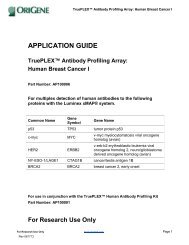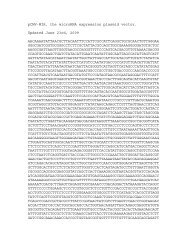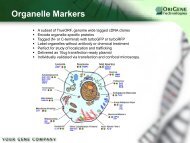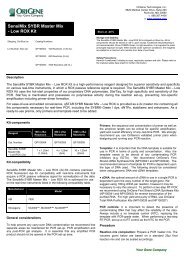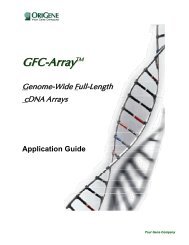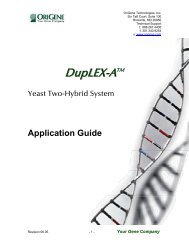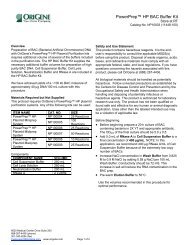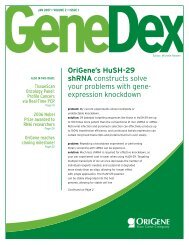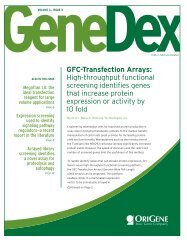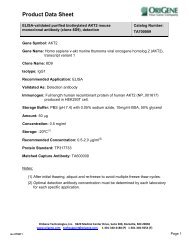miRNA Analysis - OriGene
miRNA Analysis - OriGene
miRNA Analysis - OriGene
Create successful ePaper yourself
Turn your PDF publications into a flip-book with our unique Google optimized e-Paper software.
<strong>OriGene</strong> Technologies, Inc.<br />
MicroRNA analysis: Detection,<br />
Perturbation, and Target Validation<br />
-Optimal strategies to a successful <strong>miRNA</strong> research project
Optimal strategies to a successful<br />
<strong>miRNA</strong> research project<br />
<strong>miRNA</strong> Biology<br />
<strong>miRNA</strong> cDNA synthesis<br />
Global <strong>miRNA</strong> profiling<br />
Searching <strong>miRNA</strong>s involving in your research<br />
Specific <strong>miRNA</strong> detection<br />
and quantification<br />
<strong>miRNA</strong> expression perturbation<br />
Studying specific <strong>miRNA</strong>s<br />
<strong>miRNA</strong> targets identification<br />
Bridging the gap between <strong>miRNA</strong> and biology<br />
by identifying protein target of <strong>miRNA</strong>
Optimal strategies to a successful<br />
<strong>miRNA</strong> research project<br />
<strong>miRNA</strong> Biology<br />
<strong>miRNA</strong> cDNA synthesis<br />
Global <strong>miRNA</strong> profiling<br />
Searching <strong>miRNA</strong>s involving in your research<br />
Specific <strong>miRNA</strong> detection<br />
and quantification<br />
<strong>miRNA</strong> expression perturbation<br />
Studying specific <strong>miRNA</strong>s<br />
<strong>miRNA</strong> targets identification<br />
Bridging the gap between <strong>miRNA</strong> and biology<br />
by identifying protein target of <strong>miRNA</strong>
MicroRNAs are naturally occurring<br />
non-coding RNAs<br />
-Mature microRNA is 21-23nt (<strong>miRNA</strong>)<br />
First discovered in 1993 by Victor Ambros at Harvard (lin-4)<br />
-MiRNA are processed in multiple steps:<br />
DNA→ Pri-<strong>miRNA</strong> → Pre-<strong>miRNA</strong>→ Mature <strong>miRNA</strong><br />
Pri-<strong>miRNA</strong> : Capped & polyadenylated full length<br />
Precursors(mRNA), transcribed by RNA polymerase II<br />
Pre-<strong>miRNA</strong>: ~70nt hairpin precursor product of Drosha<br />
Mature <strong>miRNA</strong>: Functional RISC complex, product of Dicer
<strong>miRNA</strong>s regeulate of gene expression<br />
at translational level
Number of <strong>miRNA</strong> Publications<br />
<strong>miRNA</strong>s regulates many biological<br />
processes<br />
3500<br />
3000<br />
2500<br />
2000<br />
1500<br />
1000<br />
500<br />
0<br />
1993-<br />
1998<br />
1998-<br />
2000<br />
2001-<br />
2002<br />
2003-<br />
2004<br />
2005-<br />
2006<br />
2007-<br />
2008<br />
2009-<br />
2010<br />
Year of Publication<br />
First <strong>miRNA</strong>, lin-14 in C. elegans, was reported by Vector Ambros in 1993.<br />
Since then <strong>miRNA</strong> has been reported:<br />
1. Targeting most development related genes<br />
2. stem cells maintenance and differentiation.<br />
3. Cancer as oncomiR.<br />
4. Heart disease.<br />
5. Neuronal development and synapse formation.<br />
6. Viral infections process.
Optimal strategies to a successful<br />
<strong>miRNA</strong> research project<br />
<strong>miRNA</strong> Biology<br />
<strong>miRNA</strong> cDNA synthesis<br />
Global <strong>miRNA</strong> profiling<br />
Searching <strong>miRNA</strong>s involving in your research<br />
Specific <strong>miRNA</strong> detection<br />
and quantification<br />
<strong>miRNA</strong> expression perturbation<br />
Studying specific <strong>miRNA</strong>s<br />
<strong>miRNA</strong> targets identification<br />
Bridging the gap between <strong>miRNA</strong> and biology<br />
by identifying protein target of <strong>miRNA</strong>
DNA microarray<br />
qPCR<br />
Throughput whole genome on one slide 96 or 384 on one plate<br />
Sensitivity low Can detect down to 2 fold changes<br />
Sample preparation labeling RNA Converting RNA to cDNA<br />
Assay time Overnight hybridization 2hrs<br />
Cost expensive inexpensive<br />
Easy to perform difficult easy<br />
equipment Core facility Most labs<br />
qPCR method can provide<br />
•Full genome-wide coverage<br />
•High sensitivity<br />
•Easy assay in most labs
Hairpin primer<br />
Poly A tailing
Hairpin priming<br />
Poly A tailing<br />
Sensitivity for individual<br />
<strong>miRNA</strong><br />
Higher<br />
Lower<br />
Throughput Low High<br />
Representation<br />
Sample preparation includes<br />
both mRNA and <strong>miRNA</strong><br />
Only detect a<br />
subset due to 3’<br />
imprecision<br />
NO<br />
Fully coverage<br />
Yes
qSTAR qPCR microRNA detection<br />
System from <strong>OriGene</strong>.<br />
Products offered in qSTAR microRNA Detection System<br />
1<br />
Total RNA<br />
Purification Kit<br />
2<br />
First Strand cDNA<br />
Synthesis Kit<br />
3<br />
<strong>miRNA</strong> Primer Pairs or<br />
<strong>miRNA</strong> Primer Panels<br />
4<br />
<strong>miRNA</strong><br />
Template Standards<br />
5<br />
SYBR Green<br />
Master Mix<br />
cDNA1<br />
cDNA2<br />
cDNA Synthesis<br />
Mix cDNA with<br />
<strong>miRNA</strong> Primer Panels<br />
SYBR Green Master Mix<br />
qPCR results<br />
Data analysis<br />
*Components 2,3 & 4 are unique and should only be used alongside <strong>OriGene</strong>’s qPCR <strong>miRNA</strong> detection<br />
system
Changes of <strong>miRNA</strong><br />
<strong>miRNA</strong> profiling in Ovarian Cancer<br />
with <strong>OriGene</strong>’s <strong>miRNA</strong> primer panel<br />
Normal<br />
5<br />
4<br />
3<br />
2<br />
1<br />
0<br />
-1<br />
-2<br />
-3<br />
1 5 9 13 17 21 25 29 33 37 41 45 49 53 57 61 65 69 73 77 81 85 89 93<br />
Samples<br />
Ovarian Cancer<br />
1. Over 90% of the <strong>miRNA</strong>s were successfully identified in normal<br />
sample<br />
2. Ovarian cancer cDNA showed differential <strong>miRNA</strong> profiling compare<br />
to normal cDNA
<strong>miRNA</strong> template standards<br />
Copy number standards were used to determine the absolute transcript copy number of an<br />
experiment sample using the standard curve method
Optimal strategies to a successful<br />
<strong>miRNA</strong> research project<br />
<strong>miRNA</strong> Biology<br />
<strong>miRNA</strong> cDNA synthesis<br />
Global <strong>miRNA</strong> profiling<br />
Searching <strong>miRNA</strong>s involving in your research<br />
Specific <strong>miRNA</strong> detection<br />
and quantification<br />
<strong>miRNA</strong> expression perturbation<br />
Studying specific <strong>miRNA</strong>s<br />
<strong>miRNA</strong> targets identification<br />
Bridging the gap between <strong>miRNA</strong> and biology<br />
by identifying protein target of <strong>miRNA</strong>
<strong>miRNA</strong> expression perturbation<br />
Pre-<strong>miRNA</strong> precursor <strong>miRNA</strong> mimics <strong>miRNA</strong> inhibitors<br />
perturbation gain-of-function gain-of-function loss function<br />
product plasmid DNA synthetic small RNA<br />
stability<br />
mimic native<br />
condition<br />
very stable, good for<br />
studying long term<br />
function<br />
Native substrate for<br />
Drosha and Dicer.<br />
relative instable,<br />
only good for days<br />
artificial, doesn’t<br />
reflect the 3’ end<br />
imprecision
MicroRNA Expression Plasmids<br />
Features of <strong>OriGene</strong>’s pCMV6-MIR.<br />
1. <strong>miRNA</strong>s and 300 bps of flanking genomic sequences are<br />
expressed by strong CMV promoter.<br />
2. PolyA signal is added to facilitate pri-<strong>miRNA</strong> processing<br />
by Drosha.<br />
3. SV40 drive IRES-GFP expression serves great<br />
transfection marker.<br />
4. Neomycin selection enables to select stable<br />
transfections.
Validation of pCMV6-MIR system<br />
1. Sequence confirmation of the precursor sequence<br />
- All sequences are displayed on the website<br />
2. Verify the GFP expression in the transfected cells<br />
3. Demonstrate the over-expression of the intended <strong>miRNA</strong><br />
4. Demonstrate the gain-of-function of the intended <strong>miRNA</strong>
Verify the GFP expression<br />
Mir205 Mir143 Mir34b<br />
Empty Vector<br />
Non-transfected<br />
24hr after transfection
Demonstrate the over-expression<br />
MicroRNA vector untransfected<br />
Method: HEK293 cells were<br />
transfected with <strong>miRNA</strong> expression<br />
plasmids and the total RNA were<br />
isolated 48 hrs later. <strong>miRNA</strong> were<br />
detected using Poly A tailing<br />
RT_PCR.<br />
All experiments were conducted<br />
in duplicates. Beta-actin were used as<br />
normalization control.<br />
Mir205<br />
Beta-actin<br />
Mir143<br />
Beta-actin<br />
Mir34b<br />
Beta-actin<br />
24hr after transfection
Gain-of-function of miR205<br />
NM_032440<br />
Control<br />
CMV P<br />
GFP<br />
stop<br />
UTR<br />
CMV P<br />
Mir205<br />
CMV P<br />
GFP<br />
stop<br />
UTR<br />
CMV P<br />
microRNA precursor<br />
24hr after transfection
Optimal strategies to a successful<br />
<strong>miRNA</strong> research project<br />
<strong>miRNA</strong> Biology<br />
<strong>miRNA</strong> cDNA synthesis<br />
Global <strong>miRNA</strong> profiling<br />
Searching <strong>miRNA</strong>s involving in your research<br />
Specific <strong>miRNA</strong> detection<br />
and quantification<br />
<strong>miRNA</strong> expression perturbation<br />
Studying specific <strong>miRNA</strong>s<br />
<strong>miRNA</strong> targets identification<br />
Bridging the gap between <strong>miRNA</strong> and biology<br />
by identifying protein target of <strong>miRNA</strong>
<strong>miRNA</strong> targets analysis<br />
Methods pros cons<br />
Luciferase reporter Easy, Sensitive and reliable Require premade reporter<br />
construct<br />
Western blot Less sensitive, very definitive Most antibodies are not<br />
available<br />
DNA microarray<br />
Whole genome coverage, high<br />
throughput<br />
In silica predication Easy Error-prone<br />
Changes in mRNA level<br />
have poor co-relation to<br />
<strong>miRNA</strong> function<br />
Luciferase reporter assays are the most widely used methods in <strong>miRNA</strong> target<br />
identification
Luciferase 3’ UTR reporter system from<br />
<strong>OriGene</strong><br />
•High sensitivity of Luciferase assay due to<br />
IRES-driven luciferase cassette<br />
•RFP as a reporter for transfection monitoring<br />
and normalization<br />
•Neomycin selection marker for stable cell<br />
establishment<br />
•Can serve as a control for target validation<br />
experiments.<br />
•3-UTR Clones for MicroRNA target validation<br />
•<strong>OriGene</strong> provides human genome wide 3’ UTR<br />
clones
Comparison of different luciferase<br />
reporter assays<br />
pMIR-Report<br />
(Ambion)<br />
Dual-Luciferase<br />
reporter<br />
(Promega)<br />
Sensitivity low low high<br />
pMir_Target (<strong>OriGene</strong>)<br />
Reporter firefly luciferase firefly luciferase firefly luciferase<br />
Promoter CMV (strong) PGK (weaker) SV40 (strong)<br />
Transfection marker and<br />
internal control<br />
non<br />
SV40 drives second<br />
luciferase<br />
CMV drives RFP<br />
Methods to weaken reporter<br />
expression<br />
Compatibility with <strong>OriGene</strong>’s<br />
pMir <strong>miRNA</strong> system<br />
non Weaker promoter IRES weakening the<br />
translation<br />
yes yes yes<br />
Stable transfection no no yes
Why introduce IRES?<br />
pSV40-GFP<br />
pSV40-IRES-GFP
<strong>OriGene</strong>’s design works<br />
SV40 P<br />
Neo<br />
stop<br />
IRES<br />
GFP<br />
stop<br />
SV40 P<br />
Neo<br />
stop<br />
IRES<br />
GFP<br />
stop<br />
CMV P<br />
CMV P<br />
mir205 precursor<br />
Empty reporter<br />
pCMV-Mir<br />
Empty reporter<br />
Mir205<br />
SV40 P<br />
CMV P<br />
Neo<br />
stop<br />
IRES<br />
GFP<br />
stop<br />
Mir205 target<br />
SV40 P<br />
CMV P<br />
stop<br />
Neo IRES<br />
mir205 precursor<br />
GFP<br />
stop<br />
Mir205 target<br />
Mir205 target<br />
pCMV-Mir<br />
Mir205 target<br />
Mir205
pMir-Target system validation<br />
-Interaction of mir205 with its target genes<br />
Percentage of control<br />
Table 1. 3’UTR-luciferase reporter clones in mir205 targets study<br />
Sample<br />
number<br />
1<br />
3’UTR reporter clones<br />
in pMir-Target<br />
NM_001982<br />
** *** ** * ** * ** ** **<br />
2<br />
3<br />
4<br />
5<br />
6<br />
7<br />
8<br />
NM_030751<br />
NM_001567<br />
NM_014795<br />
NM_001002814<br />
NM_001025376<br />
NM_005433<br />
NM_014962<br />
9 NM_024830<br />
10 NM_019084<br />
11 Mir205 Rev. comp.<br />
12 Empty reporter<br />
Sample Number<br />
Mir205 down-regulated luciferase activity when the<br />
luciferase was fused to mir205 target sequences (grey bar,<br />
control with 3’ UTR reporter clones; black bar, mir205 with<br />
3’ UTR reporter clones.)
pMir-Target system validation<br />
-Interaction of mir205 with its target genes<br />
Seed sequence of mir205 in the 3’ UTR of ERBB3<br />
GC<br />
GAU<br />
5’ ACAG ACUCC--UGGA AUGAAGGAU-3’<br />
||| ||||| |||| ||||||||<br />
3’ GUC--UGAGG ACCU---UACUUCCU- 5’<br />
CC<br />
AA<br />
Mutate the Seed sequence<br />
NM_001982(ERBB3)<br />
mir205<br />
Table of experiment set-ups<br />
Transfections Control Exp1<br />
Exp2<br />
pMir-Target-3UTR +<br />
+<br />
pMir-Target-3UTR mutant<br />
+<br />
MiR in pMir<br />
+ +<br />
PMir(Empty Vector)<br />
+
Percentage of control<br />
pMir-Target system validation<br />
-Interaction of mir205 with its target genes<br />
Table of experiment set-ups<br />
Transfections Control Exp1<br />
Exp2<br />
pMir-Target-3UTR +<br />
+<br />
pMir-Target-3UTR mutant<br />
+<br />
MiR in pMir<br />
+ +<br />
PMir(Empty Vector)<br />
+<br />
140<br />
120<br />
100<br />
80<br />
60<br />
40<br />
20<br />
0<br />
NM_001982<br />
NM_030751<br />
NM_001567<br />
NM_014962<br />
Empty<br />
Abolishment of Mir205 effects by mutated seeding sequences in the<br />
3’UTR-luciferase reporter clones (grey bar, control with 3’ UTR reporter<br />
clones; darker grey bar, mir205 with 3’ UTR reporter clones; black bar,<br />
mir205 with mutated 3’ UTR reporter clones.)
Optimal strategies to a successful<br />
<strong>miRNA</strong> research project<br />
<strong>miRNA</strong> Biology<br />
<strong>miRNA</strong> cDNA synthesis<br />
Global <strong>miRNA</strong> profiling<br />
Searching <strong>miRNA</strong>s involving in your research<br />
Specific <strong>miRNA</strong> detection<br />
and quantification<br />
<strong>miRNA</strong> expression perturbation<br />
Studying specific <strong>miRNA</strong>s<br />
<strong>miRNA</strong> targets identification<br />
Bridging the gap between <strong>miRNA</strong> and biology<br />
by identifying protein target of <strong>miRNA</strong>




